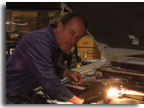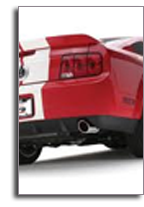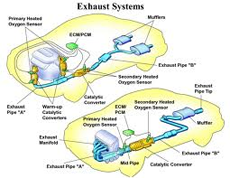
Fri, April 26, 2024
-1:30 pm
Happy Friday!
 GARY'S GARAGE TIPS
GARY'S GARAGE TIPSWhy synthetic motor oil is a good choice.
Synthetic motor oils can be a good choice for high output, turbocharged or supercharged engines, vehicles that are used for towing (especially during hot weather), or vehicles that are operated in extremely cold or hot climates. Synthetic motor oils, though several times more expensive than mineral-based motor oils, can improve fuel economy and provide longer intervals between changes. They also provide instant lubrication on start-up.
Exhaust Systems

SHOP SERVICES
|
At Scenic View Mottors we replace mufflers, tail pipes, and catalytic converters - the entire exhaust system as needed. How your Exhaust System works Your car's exhaust system carries away the gases created when the fuel and air are burned in the combustion chamber. These gases are harmful to humans and our environment. Frequent checks of your exhaust system is a must to provide for you and your family's safety. Make sure there are no holes in the exhaust system or in the passenger compartment where exhaust fumes could enter. Exhaust manifold: The exhaust manifold attaches to the cylinder head and takes each cylinders exhaust and combines it into one pipe. The manifold can be made of steel, aluminum, stainless steel, or more commonly cast iron. Oxygen sensor: All modern fuel injected cars utilize an oxygen sensor to measure how much oxygen is present in the exhaust. From this the computer can add or subtract fuel to obtain the correct mixture for maximum fuel economy. The oxygen sensor is mounted in the exhaust manifold or close to it in the exhaust pipe. Catalytic converter: This muffler like part converts harmful carbon monoxide and hydrocarbons to water vapor and carbon dioxide. Some converters also reduce harmful nitrogen oxides. The converter is mounted between the exhaust manifold and the muffler. Muffler: The muffler serves to quiet the exhaust down to acceptable levels. Remember that the combustion process is a series of explosions that create allot of noise. Most mufflers use baffles to bounce the exhaust around dissipating the energy and quieting the noise. Some mufflers also use fiberglass packing which absorbs the sound energy as the gases flow through. Exhaust pipe: Between all of the above mention parts is the exhaust pipe which carries the gas through it's journey out your tail pipe. Exhaust tubing is usually made of steel but can be stainless steel (which lasts longer due to it's corrosion resistance) or aluminized steel tubing. Aluminized steel has better corrosion resistance than plain steel but not better than stainless steel. It is however cheaper than stainless steel.
Common Problems: |
